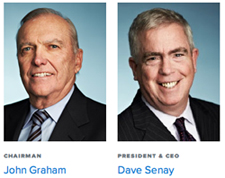 The Fleishman-Hillard unit of Omnicom, rebranding as FleishmanHillard, www.fleishmanhillard.com, has embarked on “new direction” so it can “better serve marketer clients in the 21st century,” said Stuart Elliott’s feature on the changes in the New York Times April 29. It was headlined: “The New Look of Public Relations.”
The Fleishman-Hillard unit of Omnicom, rebranding as FleishmanHillard, www.fleishmanhillard.com, has embarked on “new direction” so it can “better serve marketer clients in the 21st century,” said Stuart Elliott’s feature on the changes in the New York Times April 29. It was headlined: “The New Look of Public Relations.” Madison Ave. veterans, noting that the firm aims at bringing numerous disciplines together for more impact, say this has been done countless times before and wonder about its effectiveness.
We covered advertising in a daily column from 1964-72 for the former New York Journal-American and Chicago Tribune and wrote about the rage then which was “total communications,” a combination of ads and PR. Consumers were going to hammered into submission two different ways, went that school.
Young & Rubicam in the late 1970s “invented” the “whole egg” approach, a reprise of the same theory. In the 1990s and after that it was Integrated Marketing Communications.”
Newly added to the mix, which is beginning to sound like a stew, are social media and Big Data (tracking the demographics and buying habits of millions of consumers).
What chance does the hapless consumer have with such a barrage aimed at him or her? Maybe a lot.
FH Spending $750K on Itself
What grabbed us is that FH is spending $750,000 to promote its new image.
Had it remained in the O’Dwyer rankings, from which it was forced in 2001 by OMC, it would not need to spend such a sum to get noticed.
Taking part in such rankings is the best way to get on new biz shopping lists. Unlike awards and honors, which may last a few days in the news, rankings are present 24/7/365. They tell a non-stop story. No ad campaign can hope to bring such visibility.
The ad conglomerates, OMC, WPP, Interpublic and Publicis, started buying up many of the most famous names in PR around 1980 (19 of the 25 top-ranked O’Dwyer firms).
Financiers took over the ad agencies so that the PR firms came under two cultures hostile to the openness and interactivity that are hallmarks of PR.
PR cultures were crushed
Hill and Knowlton, the crown jewel of PR and as open as the day is long, was squashed by owner WPP. Its blue chip client list of nearly 500, proudly displayed for many years in O’Dwyer’s Directory of PR Firms, vanished. It no longer sat atop a list of more than 100 PR firms.
The conglomerates insisted that accounting rules barred them from reporting their numbers. Clients, they also said, did not want their names in any directories. They pulled themselves out of the best vehicle ever for firm promotion.
Tossing around large sums of money, the conglomerates were able to buy just about every ad agency and many, but by no means all, substantial PR firms.
Current debt of the four is $15.79 billion, with WPP’s debt of $7.66B by far the biggest. The congloms show steady growth but some analysts say they are buying their growth by going into debt. Investors have not been impressed because OMC, at $59.30 this week, is only $5.80 higher than it was 13 years ago on Dec. 19, 1999 when it was $53.50.
Edelman and Others Stayed and Grew
Edelman, which took part in the O’Dwyer rankings from their start in 1970, posted revenues of $655 million and an employee count of 4,518 for 2012 which is five times as big as the next independent.
 FH told NYT that has revenues of $500M+ and 2,500 employees but does not offer any documentation. The 127 PR firms on the 2012 O’Dwyer list have provided top pages of corporate income tax returns, W-3s showing total payroll, attestation by outside CPA firms, and client lists.
FH told NYT that has revenues of $500M+ and 2,500 employees but does not offer any documentation. The 127 PR firms on the 2012 O’Dwyer list have provided top pages of corporate income tax returns, W-3s showing total payroll, attestation by outside CPA firms, and client lists.CEO Richard Edelman, in his blog April 30, offered “A Dissenting View” to Elliott’s column headlined “The New Look of Public Relations.”
Edelman noted that FH has hired a number of top people who have advertising and graphics backgrounds.
While he agrees with FH CEO Dave Senay’s views on the convergence of media and recruitment of non-traditional talent, “Where we part company is his strategy for becoming a one-stop shop that is as much an ad agency as a PR firm. At Edelman, we are going to evolve and expand the remit of the PR business.”
“The horizontal, peer-to-peer conversation is supplanting the top-down, controlled messaging that is the essence of advertising,” wrote Edelman.
Many Ad/PR Leaders Send Wrong Message
Edelman is one of PR’s most visible executives, taking part in PR industry trade groups including the Arthur W. Page Society and PR Society of America and its Foundation and student groups.
He makes himself available to reporters and thereby sets an example for all his employees.
The opposite example is set by heads of two of the conglomerates, John Wren of OMC and Sorrell.
OMC’s offices are only about five blocks from the O’Dwyer offices and we used to attend its annual meeting since we have a few shares of stock.
That was the only time we had a chance to see him or question him. Our questions, however, elicited little information. Such meetings only lasted about five minutes before they were declared over. After a couple of years of such confrontations, Wren moved the annual meeting out of New York and across the country, never to return.
Sorrell Is Visible in U.K.
Sorrell is highly visible with the U.K. press where he trades remarks with reporters and does not hesitate to zing one that may annoy him. He has never held a press conference in New York that we know of.
Given the attitudes toward the press of Wren and Sorrell, who have also deeply cut the amount of information available on their PR acquisitions, it is no wonder that their staffs avoid press relations.
WPP, OMC and IPG have full-time people whose job is corporate press relations but we haven’t seen or heard from any of them for years although they are a few blocks from our offices.
We noted April 29 on the disappearance of personalities in PR and the same has taken place in advertising as a result of dominance by financiers.
There were numerous strong ad personalities in the 1960s through part of the 1980s including David Ogilvy, Bill Bernbach, George Lois, Rosser Reeves, Stanley Resor, Mary Wells, Norman Strouse, Jerry Della Femina, etc.
Where are such figures today? How can advertising and PR win the public’s attention if there are few celebs?


 DJE Holdings, parent of Edelman and Zeno, launches RUTH as an independent shop named after Ruth Edelman, mental health advocate, wife and longtime business partner of Dan Edelman.
DJE Holdings, parent of Edelman and Zeno, launches RUTH as an independent shop named after Ruth Edelman, mental health advocate, wife and longtime business partner of Dan Edelman. New York City PR firms make up the largest slice of O'Dwyer's 147 firm overall ranking with 33 of 40 in the New York/New Jersey area either calling Manhattan their home or having a presence there.
New York City PR firms make up the largest slice of O'Dwyer's 147 firm overall ranking with 33 of 40 in the New York/New Jersey area either calling Manhattan their home or having a presence there. Subject Matter+Kivvit, which joined forces in May, has rebranded as Avoq, an integrated shop with more than 200 professionals in Washington, New York, Asbury Park (NJ), Miami and Chicago.
Subject Matter+Kivvit, which joined forces in May, has rebranded as Avoq, an integrated shop with more than 200 professionals in Washington, New York, Asbury Park (NJ), Miami and Chicago. While PR pros stationed at in-house comms. teams and those working for agencies share many of the same objectives, they also have markedly different top priorities, according to a recent report.
While PR pros stationed at in-house comms. teams and those working for agencies share many of the same objectives, they also have markedly different top priorities, according to a recent report. Edelman is cutting 240 employees or about four percent of its workforce to cope with the cooling down of the PR sector, according to a memo from CEO Richard Edelman.
Edelman is cutting 240 employees or about four percent of its workforce to cope with the cooling down of the PR sector, according to a memo from CEO Richard Edelman.


 Have a comment? Send it to
Have a comment? Send it to 
No comments have been submitted for this story yet.